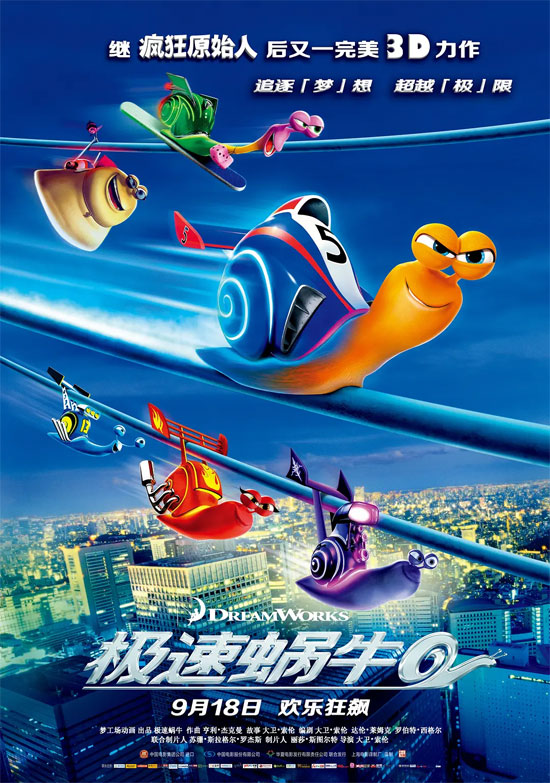Film Name: 极速蜗牛 / Turbo

Without realizing it, over the past three years I’ve watched 3.5 racing-themed animated films: “Cars 2,” “Pororo’s Racing Adventure,” and “Turbo.” The so-called 0.5 film is last year’s “Wreck-It Ralph.” So when I learned “Turbo” was coming to Chinese theaters, I didn’t have much anticipation for it. Frankly, what else could you expect? Did you really anticipate the protagonist, after relentless effort, help from friends, and cycles of despair and renewed hope, still not be the first to cross the finish line?
The core reason this genre has become so predictable is that audiences can guess the entire ending before even watching. Especially since American animation has always been bold as a bull in the journey but timid as a mouse when it comes to the conclusion.
Considering that an animated film isn’t made overnight but takes at least two to three years to complete, we can’t judge whether this film was sufficiently novel at the time of its conception using today’s genre standards. My research indicates the earliest public information about the film came from DreamWorks Animation’s official 2014 release schedule, announced in February 2011. Director David Soren later revealed the project had actually been in development for a full decade. At the time, David Soren participated in an internal pitch session at DreamWorks and won the bid with his brilliant concept of combining slow snails with high-speed car racing. However, Soren was involved in the creation of multiple films like “Shark Tale,” “Shrek,” and “How to Train Your Dragon.” By the time he finally had the opportunity to fully dedicate himself to this project, he looked around and realized that the racing theme was no longer novel.
Had “Turbo” been released before “Cars,” or at least between “Cars 1” and “Cars 2,” its competitiveness would have increased by at least 50%.
Another reason racing themes have become a mixed blessing—though perhaps not unique to this genre—is a common trait in American animation: it often portrays an idealistic path where the protagonist inevitably succeeds after finding self-acceptance. A small character has a dream, persists in pursuing it, and ultimately achieves that dream, no matter how distant or difficult it seems. Seeing this once or twice is moving; seeing it three or four times is tolerable; seeing it five or six times is mundane; seeing it seven or eight times is nauseating. If everything is this formulaic, you simply stop watching. Are there really that many? You don’t even need to count carefully—just this summer alone, Hollywood delivered three films centered on this theme: “Monsters University,” “Planes,” and “Turbo.”
Perhaps precisely because I had no expectations, the film still managed to spark some simple reflections. Standing among racing-themed films, it does possess a degree of originality. Two key points stand out: First, the snail as protagonist—an absolute rarity in animation. How to make a snail adorable—the snail on the film’s first poster looked bold and brash, but later posters reverted to a cuter aesthetic—and how to depict the snail’s world—the opening scenes in the vegetable garden, filled with all manner of snails, deliver a powerful visual impact. Second, the fusion of snails and racing. This is the film’s core premise and its raison d’être. Consequently, the film relentlessly builds credibility, convincing audiences that snails and speed are not only compatible but also make for a remarkably cool pairing.
For instance, it introduces Turbo’s signature blue trail of light, devises his unique racing tactics—like scaling walls or overtaking under rival cars—and establishes two factions (the snail crew and the human team) to support his victory. Naturally, the scientific rationale behind Turbo’s speed boost is largely negligible. Moreover, it introduces an idol who embodies Turbo’s dreams, only to become his ultimate rival.
Personally, I find it problematic that the racing world champion transforms from idol to adversary, from righteous hero to hypocritical villain, ultimately forcing Turbo to surpass him both in speed and morality to complete his rite of passage into a new hero. It makes me feel that the heroes we see on TV are fake, and that they even resort to vicious methods like crushing their enemies to defend their status. This moral decay should not be borne by the word “idol.” A more appropriate strategy might be for Turbo to inherit the unfinished business of the former world champion, his idol, and challenge a new enemy. This might be easier for the audience to accept.
Another immediate impression I had of the film was its sense of disjointedness. The 30-minute segment in the vegetable garden felt incredibly grounded and lifelike. Whether depicting the snails’ daily existence or their relationship with the tomatoes, it drew you right in. We can almost be certain this section feels so vivid because the director likely has such a vegetable garden at home, with a child riding a toy car, and a colony of snails inhabiting the plot. However, when the film shifts to the auto repair shop scenes and the ultimate race arena, we gradually detach from that comfortable, everyday state. We enter into a realm deliberately crafted, meticulously arranged, and intentionally heightened by the director. The earlier sense of ease and comfort gradually dissipates.
From this perspective, snails are rooted in everyday life, but the concept of a speeding snail remains fundamentally artificial. While the idea is brilliant, achieving realism and credibility is relatively easy; capturing the essence of life, however, proves far more challenging.
Please specify:Anime Phone Cases » Turbo 2013 Animation Film Review: Has the racing genre become a liability?